Maternal cardiac arrest is a growing concern in the USA. It often happens because of the changes in hormones and strain on the body during pregnancy. Moreover, pregnant women are particularly vulnerable to oxygen deprivation caused by cardiac arrest. The blood flow and heartbeat increases in a pregnant woman’s body to help the baby grow in the womb.
When pregnant women put mental and bodily pressure because of overtime, the risk of cardiac arrest amplifies making special considerations inevitable. Lay responders and all medical healthcare professionals learn AED and CPR which is safe to perform on pregnant women techniques. It helps them save two lives at once. The procedure should be learned from a reputed academy like ours. The CPR-certified person would be less panicky and more actively focused on saving lives.
What’s Heart Health Like In Pregnant Women?
Pregnancy puts undue stress on a pregnant woman’s heart and body. See how that happens below:
1. Increased blood volume:
The blood volume in case of maternal cardiac arrest, increases between 30-50 percent to nurture and nourish the baby growing inside.
2. Increased heartbeat:
A mother’s heartbeat will increase by about 15-20 beats/minute.
3. Increased cardiac output:
It is the amount that the heart pumps every minute. As women reach 28-34 weeks of pregnancy, their cardiac output shoots up by 30-50%. The already increased blood volume and heartbeat impact this rate. If a woman is pregnant with twins, her body’s cardiac output will increase by 60%. These changes in the heart and body of a pregnant lady can cause:
- Fatigue
- Dizziness
- Short of breath
- Palpitations because of increased heartbeat rate.
These symptoms are typical in pregnancy but overlap with other dormant heart diseases. That’s why detecting whether a pregnant woman has serious heart issues or can potentially suffer from maternal cardiac arrest is difficult without proper diagnosis. A pregnant woman will have a higher chance of heart disease because she already had one before her pregnancy.
Otherwise safe to perform, CPR and AED on a pregnant woman become more challenging because of these reasons. It’s advisable for you to get CPR-certified from American HealthCare Academy. You learn how to treat sudden cardiac arrest cases from OSHA-certified trainers. At least, you wouldn’t panic and know how to regularize the patient’s heartbeat within two minutes.
Why Do Pregnant Women Have A Sudden Cardiac Arrest?
Maternal cardiac arrest can happen due to multiple causes. But the most common reasons are:
1. Hemorrhage:
It is the most common reason for maternal cardiac arrest and is highly responsible for increasing cases of maternal death. The most causes of hemorrhage are placental abruption, ectopic pregnancy, and uterine rupture.
2. Eclampsia:
It usually happens in patient settings. Whenever the pregnant woman has seizures, Eclampsia can be detected. Pregnant women who are going through Epilepsy seizures cannot breathe normally. Their body might tighten or start to have fits.
3. Amniotic Fluid Embolism (AFE):
AFE is the condition when a pregnant woman collapses during labor, delivery, or 30 minutes after that. This might be due to acute hypotension, acute hypoxia, and respiratory disorder. Having AFE before the baby’s delivery could be fatal for both lives.
4. Sepsis:
Bacteremia in the absence of the required white cell count resulting in severe sepsis shock and causing maternal cardiac arrest. They collapse, unable to handle the impact.
5. Cardiac disease:
Most pregnant women collapse and have sudden cardiac arrest because of pre-existing heart issues. These issues go undetected because pregnant women already have a higher blood volume and heart rate.
6. Drug toxicity or overdose:
Drug overdose or toxicity is one of the most common causes of maternal cardiac arrest. Pregnant women should be highly cautious about consuming numerous drugs. They must get the right prescription from their gynecologist first. Often, injecting anesthesia into pregnant women can cause them to collapse due to multiple adverse reactions.
How To Give CPR To A Pregnant Woman?
Rescuers must understand the CPR pregnant patient position before attempting or performing CPR. This will increase and improve the pregnant patient’s chances of surviving. Let us look at the special considerations and the steps to perform CPR on a pregnant woman.
- Shout out and look for help. Keep talking to the woman meanwhile to motivate her to stay conscious.
- Don’t forget to call 911 and seek the help of a health professional.
- Slightly move the lady to 45 degrees angle and see if she’s bleeding or injured.
- Use a jacket or any soft cloth to give her back support. Ensure that the entire baby’s weight is not the lady’s body by following this step.
- Check for the pregnant woman’s pulse rate. Check for the airflow next. AED And CPR on pregnant women lessons are crucial to remember in this situation.
- Keep monitoring her breathing and pulse rate.
- Place your hands over the woman’s chest and give her 30 chest compressions in 30 seconds.
- Then give her mouth-to-mouth rescue breaths two times.
- Keep repeating this step until the advanced medical help arrives.
Use Of AED On A Pregnant Woman
The use of AED is applicable to the pregnant woman experiencing cardiac arrest. The AED walks the lay responders through the instructions to analyze the patient’s heartbeat and determine if she’s in shock. Look for the diagram on the AED box to know where to place the AED pads on the pregnant woman.
Conclusion:
AED And CPR on pregnant women aren’t always safe to perform. You need to have the proper knowledge, so you don’t start panicking seeing someone about to lose their life without help. The American HealthCare Academy’s comprehensive AED and CPR certification course is AHA-compliant. Enroll in our course today for group and corporate discounts.













